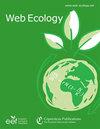识别社会生态差距,促进生物保护行动
IF 2.4
3区 环境科学与生态学
Q2 ECOLOGY
引用次数: 5
摘要
摘要在全球范围内,大多数干旱地区的裸地都被生物结壳覆盖,这些生物结壳在改变几种土壤表面性质和驱动关键生态系统过程中起着至关重要的作用。这些关键群落面临着重大威胁(如气候变化),使它们的保护面临风险,进而危及它们所居住的生态系统的可持续性。因此,迫切需要制定生态系统管理战略,以确保其得到保护。然而,为了提供一条通向生物硬壳保护的坚实道路,利益相关者和治理结构对这些群落的生态功能、它们作为利益提供者的角色以及威胁它们重要作用的压力的理解是必不可少的。尽管在过去的几十年里,生物结壳的生态范围得到了广泛的研究,但其作用的社会层面仍未得到探索。通过从社会生态学的角度回顾生物结壳方面的文献,我们确定了需要解决的知识缺口和新的研究领域,以便产生更好地指导旱地保护政策和行动的科学知识。这一研究议程是推进生物硬壳保护的先决条件。本文章由计算机程序翻译,如有差异,请以英文原文为准。
Identifying social–ecological gaps to promote biocrust conservation actions
Abstract. Globally, most bare-looking areas in dryland regions are
covered by biocrusts which play a crucial role in modifying several soil
surface properties and driving key ecosystem processes. These keystone
communities face important threats (e.g. climate change) that place
their conservation at risk and in turn the sustainability of the ecosystems
they inhabit. Therefore, there is an urgent need to develop ecosystem
management strategies to ensure their protection. However, to provide a
solid path towards biocrust conservation, the
understanding by stakeholders and governance structures of the
ecological functions of these communities, their role as benefit providers,
and the pressures threatening their important effects are indispensable. Whereas the
ecological scope of biocrust has been widely studied in the last decades,
the social dimension of their role remained unexplored. By reviewing
literature in biocrusts from a social–ecological approach, here we
identified knowledge gaps and new research areas that need to be addressed
in order to produce scientific knowledge that better guides dryland
conservation policies and actions. This research
agenda is a prerequisite to advance biocrust conservation.
求助全文
通过发布文献求助,成功后即可免费获取论文全文。
去求助
来源期刊

Web Ecology
Agricultural and Biological Sciences-Ecology, Evolution, Behavior and Systematics
CiteScore
4.60
自引率
0.00%
发文量
6
审稿时长
17 weeks
期刊介绍:
Web Ecology (WE) is an open-access journal issued by the European Ecological Federation (EEF) representing the ecological societies within Europe and associated members. Its special value is to serve as a publication forum for national ecological societies that do not maintain their own society journal. Web Ecology publishes papers from all fields of ecology without any geographic restriction. It is a forum to communicate results of experimental, theoretical, and descriptive studies of general interest to an international audience. Original contributions, short communications, and reviews on ecological research on all kinds of organisms and ecosystems are welcome as well as papers that express emerging ideas and concepts with a sound scientific background.
 求助内容:
求助内容: 应助结果提醒方式:
应助结果提醒方式:


